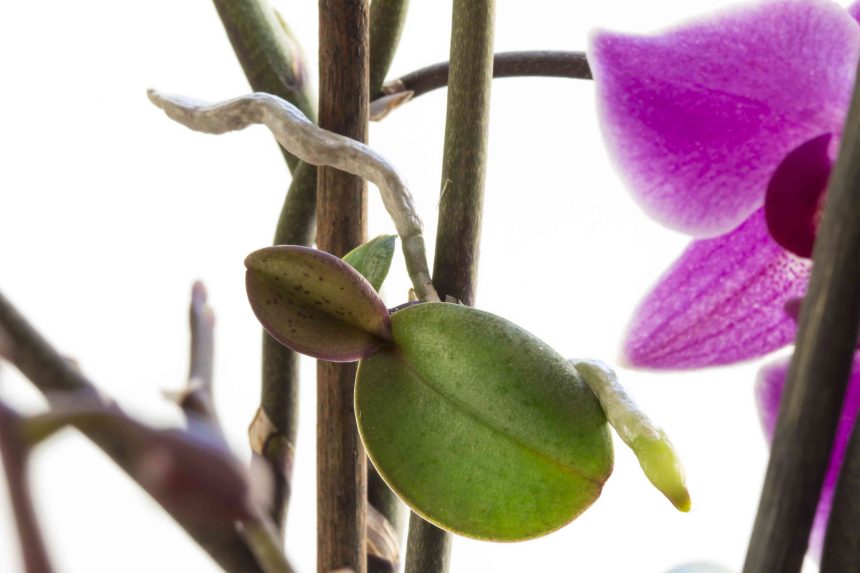The internet is full of weird and wonderful houseplant hacks. One currently doing the rounds suggests propagating orchid leaves in rice.
We spoke to two orchid experts who explained why pulling leaves off your prized plant to try this method will likely lead to disappointment. They offered insight into what proven practices they suggest trying for tricky-to-propagate orchids instead.
Meet the Expert
- Dr. Helen Millner is the President of the Orchid Society of Great Britain and has been growing orchids for over 30 years.
- André Roux has been growing orchids for 30 years and has been an accredited judge for over 20. He has been a member of the Orchid Society of Great Britain since 2007.
Why Is Propagating Orchid Leaves In Rice Not a Good Idea?
Propagating orchids from leaves—even when it’s not in rice—is extremely rare. Orchid expert André Roux explains that the only orchid genus he is aware of where propagation from leaves is both possible and successful is Restrepia.
However, he points out that this isn’t an orchid commonly available commercially, and it is sphagnum moss, not rice, used for Restripia leaf propagation.
“Orchids have been cultivated for hundreds of years, by amateurs, professionals, and those in horticultural and scientific research, and I’m sure that in all that time, we would know if it was possible to grow Phalaenopsis and other genera from leaf cuttings,” Roux says.
Dr. Helen Millner, President of the Orchid Society of Great Britain, further explains the science behind why leaf propagation is rarely successful in orchids.
“You can only propagate the plant from the growing point that has meristematic tissue,” she says.
Phalaenopsis orchids are some of the most common types grown as houseplants, and Dr. Millner explains that the meristematic tissue is found in the nodes of their flowering stems.
“So, if you pull a leaf off and leave the node on the bottom of the stem, it doesn’t matter what you do with the leaf, it’s not going to propagate because there is no node,” she says.
Want more gardening tips? Sign up for our free gardening newsletter for our best growing tips, troubleshooting hacks, and more!
What Are the Best Orchid Propagation Methods?
Instead of wasting time and energy on testing out propagating orchid leaves in rice, there are other tried and tested techniques for successful orchid propagation.
However, the propagation method you should select depends on the type of orchid you are working with. Below are three of the most common orchid propagation methods hobbyists can try.
Division
Division is the easiest way to propagate orchids, but it’s only possible with some genera.
“Those suitable for division have a sympodial growth habit, which means they grow out at the side,” Dr. Millner says. She explains that this allows you to cut the orchid in half to create two plants, each with at least one new shoot or vegetative bud.
“Phalaenopsis have what is called a monopodial growth, which means it grows upwards,” Dr. Millner says. “If you try to divide Phalaenopsis, you would break the plant in half.”
Offshoots
Dr. Millner explains that some orchids, such as Phalaenopsis and Dendrobium, will spontaneously produce offshoots from the nodes along the flowering stem. These baby plants, known as orchid “keikis”, can be removed to grow separately.
However, Dr. Millner cautions that it’s a matter of luck as to whether keikis will form. Plus, once separated, if the nodes take root successfully, it can take several years for them to bloom.
Backbulbs
Some orchids, such as Cattleya and Cymbidiums, have pseudobulbs. These succulent stems grow off the plant rhizomes and store water and nutrients.
Old, dormant pseudobulbs are known as backbulbs, and sometimes these can be separated and encouraged to actively grow again to create a new plant.
However, removing backbulbs can be stressful for the parent plant, and if you are successful, the new orchid might not bloom for several years.
Top Orchid Propagation Tips
Orchid propagation is notoriously tricky, but these tips can help increase your chances of success.
- Pick the right species: Selecting an orchid from a sympodial genera that lends itself well to division offers the best chance of success. Dr. Millner says this includes Cymbidium, Oncidium, and Dendrobium orchids.
- Avoid seed propagation: At least if you want speedy success. “An average home grower wouldn’t be able to produce orchids from seed because they have to be grown on sterile agar, and the agar has to have the nutrients in it to enable seeds to germinate and grow,” Dr. Millner says. This slow process is typically conducted under sterile lab conditions.
- Purchase some paste: Dr. Millner recommends using “keiki paste” when trying to propagate from nodes. “This encourages the nodes to produce roots and shoots,” she says.







